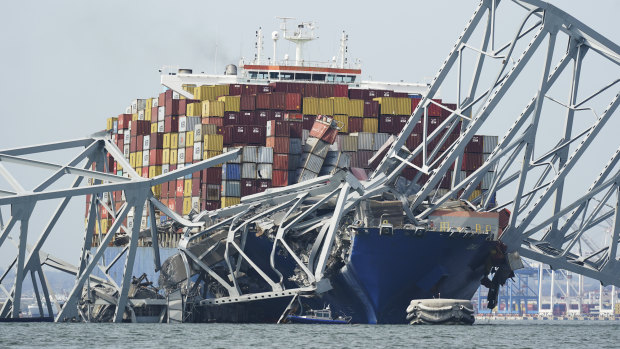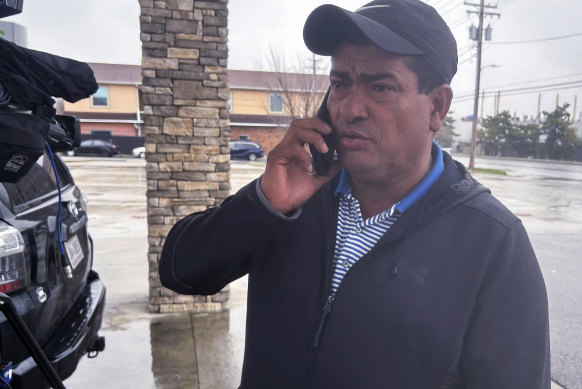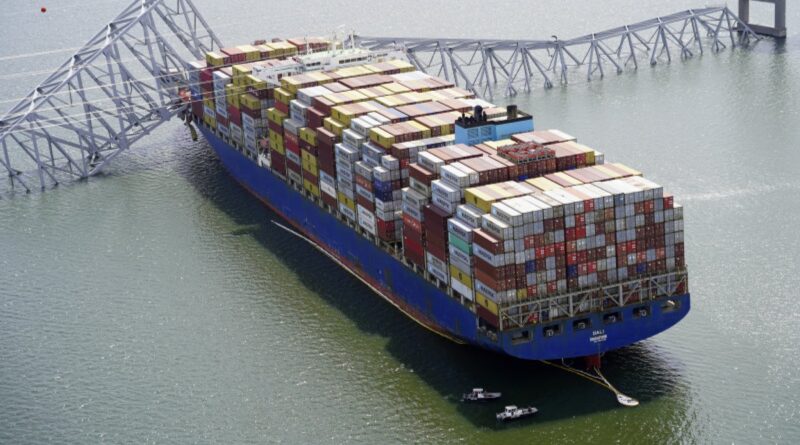Divers find two bodies in submerged truck near destroyed bridge, four still missing
Baltimore: The bodies of two construction workers who were killed when a cargo ship lost power and crashed into a Baltimore bridge have been found in a pick-up truck submerged in the Patapsco River.
Investigators have also retrieved a data recorder from the ship and have begun interviewing crew members who are still on board the vessel, in a bid to find out what caused the tragic collision.

A Coast Guard cutter passes a cargo ship that is stuck under part of the destroyed Francis Scott Key Bridge.Credit: AP
“It’s too early to speculate, of course, what NTSB [National Transportation Safety Board] will find, but if they discover or determine anything that should be considered in the regulation, inspection, design, or funding of bridges in the future, we will be ready to apply those findings,” said Pete Buttigieg, the Biden administration’s transport boss.
The developments come two days after a cargo ship the length of almost three football fields lost propulsion before crashing into the Francis Scott Key Bridge where eight men were fixing potholes about 1.30am on Tuesday (Baltimore time), resulting in the four-lane arterial collapsing almost immediately.
The bodies of two of six missing workers were discovered by divers just before 10am Wednesday morning (Baltimore time), inside a red pick-up truck submerged in about eight metres of water. They were identified as Alejandro Hernandez Fuentes, 35, and Dorlian Castillo Cabrera, 26.
Another man who is presumed dead has been identified by his brother as Maynor Yassir Suazo Sandoval, a Baltimore father who came to the US from Honduras in 2003.
Father of three Miguel Luna, a local resident originally from El Salvador, was also identified by non-profit organisation Casa, which provides services to immigrant communities, and later by his wife in an interview with Spanish network Telemundo.
“Our hearts ache for the families of the victims and all those impacted by this horrific accident,” said the group’s executive director Gustavo Torres.
Most of the workers were employed by Maryland construction contractor Brawner Builders. Two of them were rescued soon after the crash, but dozens of divers braved treacherous weather conditions on Wednesday in a bid to find the others beneath the twisted metal that was once one of Baltimore’s most iconic bridges.

Maynor Yassir Suazo Sandoval, one of the maintenance crew presumed dead after the Baltimore bridge collapse.Credit: AP
As for the ship, Vice Admiral Peter Gautier, the US Coast Guard deputy commandant for operations, said it remains stable in the waters of the Patapsco, but has more than 1.5 million gallons of fuel and lube oil on board.
The ship was undergoing “routine engine maintenance” in the port before the incident but authorities were not informed of any problems.
Fifty-six of the 4700 cargo containers on board contain hazardous materials, Gautier said, and two cargo containers with non-hazardous material are missing overboard.
As the recovery continues, attention also shifted to the economic impact of the crash, which experts fear could cost up to $US15 million ($23 million) for each day the Port of Baltimore is closed.
The port is a major employer in the US, providing more than 15,000 direct jobs and almost 140,000 indirect jobs. It is also used by companies such as Amazon, Ford and Domino Sugar, whose Baltimore refinery is the biggest in the western hemisphere.
But about 14 ships now remain stuck in the port, while the loss of the bridge has knocked out a major thoroughfare, not just for the blue-collar communities at each end of it, but also for millions of Americans who used the bridge en route from Washington DC and Maryland, to states such as New York and Delaware.
Tinglong Dai, a professor at the Johns Hopkins Carey Business School, said the port played “a very big role” in the local, regional and national economy. But he believed the supply chain was resilient enough to cope as some cargo was already being re-routing to other ports across the US.
“The Port of Baltimore is not among the largest port in the United States, let alone in the world, but it’s niche, or very specialised, especially in automobile and truck imports and exports,” he said.
“We’re going to see more re-routing happening in the coming months, if not the coming year, so I would expect the impact to be relatively local and the minimum and short term.”
Tuesday’s collision took place shortly after the cargo ship, known as the Dali, left for what was meant to be a 27-day journey to Sri Lanka.

Carlos Suazo Sandoval speaks with a reporter on the phone about his younger brother, Maynor Yassir Suazo Sandoval, who had been working on the bridge at the time of its collapse. Credit: AP
But as it approached the Francis Scott Key Bridge, it lost propulsion and was unable to slow down. A mayday was issued – which allowed authorities to stop traffic from entering – but the maintenance workers had no time to evacuate. All eight fell into the Patapsco River as the bridge crumpled on impact.
Having woken up on Tuesday morning to the extraordinary images of the iconic bridge collapsing, Baltimore continues to process the tragedy.
At the Mt Olive Baptist Church, government officials and faith leaders held a vigil on Tuesday night to honour the victims and pledge support for their families.
On one of the main highways connecting the city to Washington DC, a billboard for first responders proudly declares: “Thank you for responding at Key Bridge.”
And across the city, residents remain stunned by the loss of what was an iconic fixture in the city’s skyline for almost half a century.
“It was just a shocking way to wake up yesterday morning,” said Rachel Sangree, a local academic.
“This is an iconic Baltimore structure that I’ve seen every day in the 20-plus years I’ve lived in the area.”
Get a note directly from our foreign correspondents on what’s making headlines around the world. Sign up for the weekly What in the World newsletter here.
Most Viewed in World
Loading

